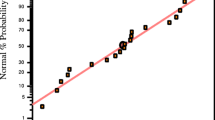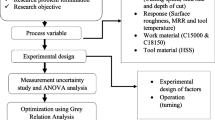Abstract
In this article, the effects of material hardness and high-pressure coolant jet over dry machining are evaluated in respect of surface roughness and cutting temperature using Taguchi L36 orthogonal array. The experimental data was analyzed using empirical cumulative distribution function and box plot with respect to material hardness and machining environment. Afterward, optimization of the quality responses is performed using signal-to-noise ratio. As part of Taguchi optimization, the “smaller is better” was adopted as optimization principle; the design of experiment was used for parameters orientation, and the analysis of variance was used for determining the effects of control factors. For the present experimental studies, three types of hardened steels (40 HRC, 48 HRC, and 56 HRC) were turned by coated carbide insert at industrial speed–feed combinations under both dry and high-pressure coolant jet. Depth of cut, being a less significant parameter, was kept fixed. The high-pressure coolant jet was found successful in reducing cutting temperature, surface roughness, and tool wear. The statistical analysis showed that work material hardness is the most significant factor for both cutting temperature and surface roughness. However, for surface roughness, other variables exerted somewhat similar contribution, while in determining the cutting temperature, the environment demonstrated crucial role. The confirmation tests showed 15.85 and 0.28 % error in predicting surface roughness and cutting temperature, respectively.
Similar content being viewed by others
References
Chinchanikar S, Choudhury S (2015) Machining of hardened steel—experimental investigations, performance modeling and cooling techniques: a review. Int J Mach Tools Manuf 89:95–109
Agrawal A, Goel S, Rashid WB, Price M (2015) Prediction of surface roughness during hard turning of AISI 4340 steel (69 HRC). Appl Soft Comput 30:279–286
Aouici H, Yallese MA, Chaoui K, Mabrouki T, Rigal J-F (2012) Analysis of surface roughness and cutting force components in hard turning with CBN tool: prediction model and cutting conditions optimization. Measurement 45(3):344–353
Özel T, Karpat Y (2005) Predictive modeling of surface roughness and tool wear in hard turning using regression and neural networks. Int J Mach Tools Manuf 45(4):467–479
Singh D, Rao PV (2007) A surface roughness prediction model for hard turning process. Int J Adv Manuf Technol 32(11–12):1115–1124
Matsumoto Y, Hashimoto F, Lahoti G (1999) Surface integrity generated by precision hard turning. CIRP Ann Manuf Technol 48(1):59–62
Suresh R, Basavarajappa S, Samuel G (2012) Some studies on hard turning of AISI 4340 steel using multilayer coated carbide tool. Measurement 45(7):1872–1884
Nalbant M, Gökkaya H, Sur G (2007) Application of Taguchi method in the optimization of cutting parameters for surface roughness in turning. Mater Des 28(4):1379–1385
Kirby ED, Zhang Z, Chen JC, Chen J (2006) Optimizing surface finish in a turning operation using the Taguchi parameter design method. Int J Adv Manuf Technol 30(11–12):1021–1029
Bouacha K, Yallese MA, Khamel S, Belhadi S (2014) Analysis and optimization of hard turning operation using cubic boron nitride tool. Int J Refract Met Hard Mater 45:160–178
Hamdan A, Sarhan AA, Hamdi M (2012) An optimization method of the machining parameters in high-speed machining of stainless steel using coated carbide tool for best surface finish. Int J Adv Manuf Technol 58(1–4):81–91
Senthilkumar N, Tamizharasan T, Anandakrishnan V (2014) Experimental investigation and performance analysis of cemented carbide inserts of different geometries using Taguchi based grey relational analysis. Measurement 58:520–536
Asiltürk I, Neşeli S (2012) Multi response optimisation of CNC turning parameters via Taguchi method-based response surface analysis. Measurement 45(4):785–794
Pawade RS, Joshi SS (2011) Multi-objective optimization of surface roughness and cutting forces in high-speed turning of Inconel 718 using Taguchi grey relational analysis (TGRA). Int J Adv Manuf Technol 56(1–4):47–62
Tsao C (2009) Grey–Taguchi method to optimize the milling parameters of aluminum alloy. Int J Adv Manuf Technol 40(1–2):41–48
Akıncıoğlu S, Gökkaya H, Uygur İ (2016) The effects of cryogenic-treated carbide tools on tool wear and surface roughness of turning of Hastelloy C22 based on Taguchi method. Int J Adv Manuf Technol 82(1–4):303–314
Zębala W, Kowalczyk R (2014) Estimating the effect of cutting data on surface roughness and cutting force during WC-Co turning with PCD tool using Taguchi design and ANOVA analysis. Int J Adv Manuf Technol 77(9–12):2241–2256
Karabulut Ş (2015) Optimization of surface roughness and cutting force during AA7039/Al 2 O 3 metal matrix composites milling using neural networks and Taguchi method. Measurement 66:139–149
Dinesh S, Senthilkumar V, Asokan P, Arulkirubakaran D (2015) Effect of cryogenic cooling on machinability and surface quality of bio-degradable ZK60 Mg alloy. Mater Des 87:1030–1036
Dosbaeva G, El Hakim M, Shalaby M, Krzanowski J, Veldhuis S (2015) Cutting temperature effect on PCBN and CVD coated carbide tools in hard turning of D2 tool steel. Int J Refract Met Hard Mater 50:1–8
Xie J, Luo M, Wu K, Yang L, Li D (2013) Experimental study on cutting temperature and cutting force in dry turning of titanium alloy using a non-coated micro-grooved tool. Int J Mach Tools Manuf 73:25–36
Hosseini S, Beno T, Klement U, Kaminski J, Ryttberg K (2014) Cutting temperatures during hard turning—measurements and effects on white layer formation in AISI 52100. J Mater Process Technol 214(6):1293–1300
Huang K, Yang W, Chen Q, He S (2015) An experimental investigation of temperature distribution in workpiece machined surface layer in turning. Int J Adv Manuf Technol 1–9
Shihab SK, Khan ZA, Mohammad A, Siddiqueed AN (2014) RSM based study of cutting temperature during hard turning with multilayer coated carbide insert. Procedia Mater Sci 6:1233–1242
Mia M, Dhar NR (2015) Effect of high pressure coolant jet on cutting temperature, tool wear and surface finish in turning hardened (HRC 48) steel. J Mech Eng 45(1):1–6
da Silva RB, Machado ÁR, Ezugwu EO, Bonney J, Sales WF (2013) Tool life and wear mechanisms in high speed machining of Ti–6Al–4V alloy with PCD tools under various coolant pressures. J Mater Process Technol 213(8):1459–1464
Naves V, Da Silva M, Da Silva F (2013) Evaluation of the effect of application of cutting fluid at high pressure on tool wear during turning operation of AISI 316 austenitic stainless steel. Wear 302(1):1201–1208
Çolak O (2012) Investigation on machining performance of inconel 718 in high pressure cooling conditions. Strojniški Vestnik J Mech Eng 58(11):683–690
Bermingham M, Palanisamy S, Kent D, Dargusch M (2012) A comparison of cryogenic and high pressure emulsion cooling technologies on tool life and chip morphology in Ti–6Al–4V cutting. J Mater Process Technol 212(4):752–765
Kramar D, Krajnik P, Kopac J (2010) Capability of high pressure cooling in the turning of surface hardened piston rods. J Mater Process Technol 210(2):212–218
Pontes FJ, de Paiva AP, Balestrassi PP, Ferreira JR, da Silva MB (2012) Optimization of radial basis function neural network employed for prediction of surface roughness in hard turning process using Taguchi’s orthogonal arrays. Expert Syst Appl 39(9):7776–7787
Dhar N, Paul S, Chattopadhyay A (2002) Role of cryogenic cooling on cutting temperature in turning steel. J Manuf Sci Eng 124(1):146–154
Diniz AE, Micaroni R (2002) Cutting conditions for finish turning process aiming: the use of dry cutting. Int J Mach Tools Manuf 42(8):899–904
Cetin MH, Ozcelik B, Kuram E, Demirbas E (2011) Evaluation of vegetable based cutting fluids with extreme pressure and cutting parameters in turning of AISI 304L by Taguchi method. J Clean Prod 19(17):2049–2056
Hua J, Shivpuri R, Cheng X, Bedekar V, Matsumoto Y, Hashimoto F, Watkins TR (2005) Effect of feed rate, workpiece hardness and cutting edge on subsurface residual stress in the hard turning of bearing steel using chamfer+ hone cutting edge geometry. Mater Sci Eng A 394(1):238–248
Debnath S, Reddy MM, Yi QS (2016) Influence of cutting fluid conditions and cutting parameters on surface roughness and tool wear in turning process using Taguchi method. Measurement 78:111–119
Xavior MA, Adithan M (2009) Determining the influence of cutting fluids on tool wear and surface roughness during turning of AISI 304 austenitic stainless steel. J Mater Process Technol 209(2):900–909
Lalwani D, Mehta N, Jain P (2008) Experimental investigations of cutting parameters influence on cutting forces and surface roughness in finish hard turning of MDN250 steel. J Mater Process Technol 206(1):167–179
Sahin Y, Motorcu AR (2005) Surface roughness model for machining mild steel with coated carbide tool. Mater Des 26(4):321–326
Yuan S, Yan L, Liu W, Liu Q (2011) Effects of cooling air temperature on cryogenic machining of Ti–6Al–4V alloy. J Mater Process Technol 211(3):356–362
Malagi R, Rajesh B (2012) Factors influencing cutting forces in turning and development of software to estimate cutting forces in turning. Int J Eng Innov Technol 2:14–30
Devillez A, Le Coz G, Dominiak S, Dudzinski D (2011) Dry machining of Inconel 718, workpiece surface integrity. J Mater Process Technol 211(10):1590–1598
Günay M, Yücel E (2013) Application of Taguchi method for determining optimum surface roughness in turning of high-alloy white cast iron. Measurement 46(2):913–919
Author information
Authors and Affiliations
Corresponding author
Rights and permissions
About this article
Cite this article
Mia, M., Dhar, N.R. Optimization of surface roughness and cutting temperature in high-pressure coolant-assisted hard turning using Taguchi method. Int J Adv Manuf Technol 88, 739–753 (2017). https://doi.org/10.1007/s00170-016-8810-2
Received:
Accepted:
Published:
Issue Date:
DOI: https://doi.org/10.1007/s00170-016-8810-2




